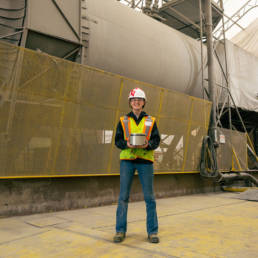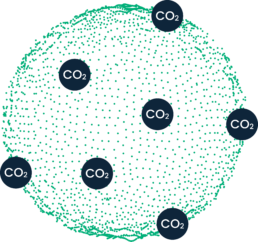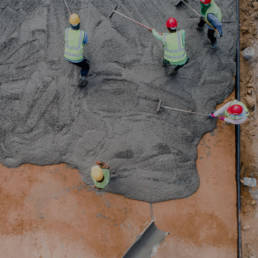Our Technology
Improve Material Performance and Store CO2
Carbon Upcycling is a waste and carbon utilization company, unlocking a new frontier of circular materials. Our technology combines CO2 with local industrial byproducts and natural materials to improve the performance of cement, plastics, consumer products, fertilizers, and even pharmaceuticals.
Since 2014, we’ve scaled the technology over 4 MILLION times in size—starting with a reactor that holds just over a few grams to a small-commercial reactor that holds 20 TONNES. Our small-commercial reactor harnesses CO2 emissions directly from a natural gas power plant. By capturing emissions at the source, they never have the chance to enter the atmosphere.


How It Works
Combining CO2 with industrial byproducts or natural materials
Our technology works by taking industrial byproducts or natural minerals and combining them with a CO2 source (either from low or high-purity CO2 sources) in our large catalytic reactors. Our patented reactor exfoliates the surface area of each particle of feedstock. Then we introduce CO2 into the reactor. It binds to these particles in a chemical reaction that creates our unique materials and sequesters CO2. The rougher the particles, the more surface area there is, allowing for greater CO2 binding, improving CO2 sequestration, product quality and reactivity all at the same time.
We’ve specifically designed our technology to work with a wide range of feedstocks, entire categories of materials from local industrial byproducts to naturally occurring minerals. Many of the feedstocks are locally (where ever you are) available in large volumes, and so far we have successfully demonstrated over 25 different ones, including fly ash, silicates, aggregate fines, and more.
By utilizing locally available materials, we remove the need to import foreign feedstocks and remove the strain on supply chains in cement production and plastics. This helps keep costs low.
Applicable Markets
Our technology will usher in an age of carbon utilization across many industries, but we’re focused first on the biggest industrial challenges where our technology can have the largest impact on mitigating the effects of climate change.

Concrete
Cement and concrete production accounts for 8% of global CO2 emissions today. This is already a massive challenge to decarbonize and only getting bigger. Our technology opens up a new class of cement alternatives that reduce emissions in concrete, improve performance, and create local supply chains to reduce cost.

Advanced Materials
Our technology catalyzes new categories of feedstocks for plastics, paper and more. The result is a new caliber and quality of advanced materials that are incredibly durable, elegant, and sustainable.
